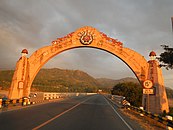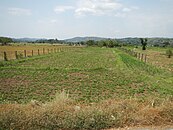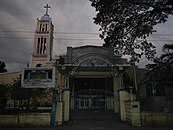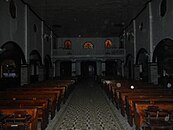Rosario | |
|---|---|
| Municipality of Rosario | |
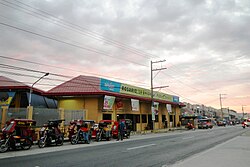 Rosario town center | |
 Map of La Union with Rosario highlighted | |
Location within the
Philippines | |
| Coordinates: 16°14′N 120°29′E / 16.23°N 120.48°E | |
| Country | Philippines |
| Region | Ilocos Region |
| Province | La Union |
| District | 2nd district |
| Founded | 1869 |
| Barangays | 33 (see Barangays) |
| Government | |
| • Type | Sangguniang Bayan |
| • Mayor | Bellarmin A. Flores II |
| • Vice Mayor | Bellarmin C. Flores III |
| • Representative | Dante S. Garcia |
| • Municipal Council | Members |
| • Electorate | 36,528 voters ( 2022) |
| Area | |
| • Total | 73.98 km2 (28.56 sq mi) |
| Elevation | 202 m (663 ft) |
| Highest elevation | 945 m (3,100 ft) |
| Lowest elevation | 28 m (92 ft) |
| Population (2020 census)
[3] | |
| • Total | 60,278 |
| • Density | 810/km2 (2,100/sq mi) |
| • Households | 14,433 |
| Economy | |
| • Income class | 1st municipal income class |
| • Poverty incidence | 3.55 |
| • Revenue | ₱ 261.7 million (2020) |
| • Assets | ₱ 522.2 million (2020) |
| • Expenditure | ₱ 175.3 million (2020) |
| • Liabilities | ₱ 141.4 million (2020) |
| Service provider | |
| • Electricity | La Union Electric Cooperative (LUELCO) |
| Time zone | UTC+8 ( PST) |
| ZIP code | 2506 |
| PSGC | |
| IDD : area code | +63 (0)72 |
| Native languages | Ilocano Pangasinan Tagalog |
Rosario, officially the Municipality of Rosario ( Ilocano: Ili ti Rosario; Pangasinan: Baley na Rosario; Filipino: Bayan ng Rosario), is a 1st class municipality in the province of La Union, Philippines. According to the 2020 census, it has a population of 60,278 people. [3]
The Kennon Road starts from this town and ends in Baguio. It is accessible via the MacArthur Highway, or via the NLEX ( North Luzon Expressway) and TPLEX ( Tarlac–Pangasinan–La Union Expressway), which will have its terminus in this town.
Etymology

There are several legends that explain how Rosario first got its name. The best known says that the name "Rosario" came from the phrase “rosas del rio,” a reference to the beautiful landscape of the area when it was first discovered by Spaniards, with narrow valleys, wild animals, birds, rivers, brooks, dense forest, and the riverscape.
Another version or story suggests that name was a reference to the long range of foothills visible to the west of the Poblacion, which appear like big Rosary beads, forming a long, rocky, giant rosary.
Yet another legend first documented in 1887 [5] associates the name of the town with a legendary creature called a Marukos (spelled "manrukos" in the 1887 text). In the legend, a group of youths were playing around and being noisy while loitering around near the floodplains of the Bued River between Rosario and Sison on a Sunday. They were then confronted by an old man in white garb, whose flesh looked like a corpse - the Marukos. The creature accused them of engaging in leisure activities on a holy day and put a curse on them, causing them to lose their sense of direction. As a result, they failed to notice that they were about to be swept away by one of the flash floods that often plagued the river. In the end, only a young girl survived the encounter with the Marukos, by clinging to a "Balingkawanay" ( Pittosporum pentandrum) tree. [5] According to the account, some stories claim that the girl had survived by praying the Rosary, while other stories say that her name was Rosario. Either way, the story of the Marukos became closely associated with the etymology of the town of Rosario, which used to be part of Pangasinan. [6]
History
Rosario was formerly a part of Santo Tomas and became a municipality in 1869 by a decree. Natives of Rosario emanated from Santo Tomas and Magsingal ( Ilocos Sur), and also from Agoo, Tubao, Aringay, San Fernando and Bacnotan, thus by the end of the 19th century, Rosario became home to mostly Ilocanos, Ilocanized Pangasinenses, & Pangasinenses still speaking their native language.
It was Don Mariano Posadas, Don Mariano Narcelles and Don Gavino Ordoña, who filed a petition with the authorities for the conversion of Rosario to a town from sitio or barangay. In 1869, the Spanish Provincial Governor created Rosario town and appointed Don Agustin Isidro de Guzman as its first Capitan Municipal.
Geography
Rosario is the southernmost town of La Union, so it is referred to as the “Gateway to Ilocandia”. Rosario's national highway passes along a mountain at barangay Agat (of Sison, Pangasinan), then into the Bued bridge (the boundary marker between La Union and Pangasinan).
Rosario is 215 kilometres (134 mi) away from Metro Manila and 54 kilometres (34 mi) from San Fernando, the provincial capital. The flight distance between Manila and Rosario is 189 kilometres (117 mi). [7]
Climate
| Climate data for Rosario, La Union | |||||||||||||
|---|---|---|---|---|---|---|---|---|---|---|---|---|---|
| Month | Jan | Feb | Mar | Apr | May | Jun | Jul | Aug | Sep | Oct | Nov | Dec | Year |
| Mean daily maximum °C (°F) | 30 (86) |
31 (88) |
32 (90) |
33 (91) |
32 (90) |
30 (86) |
29 (84) |
29 (84) |
29 (84) |
30 (86) |
30 (86) |
30 (86) |
30 (87) |
| Mean daily minimum °C (°F) | 19 (66) |
20 (68) |
21 (70) |
23 (73) |
24 (75) |
24 (75) |
24 (75) |
24 (75) |
24 (75) |
23 (73) |
21 (70) |
20 (68) |
22 (72) |
| Average precipitation mm (inches) | 15 (0.6) |
16 (0.6) |
24 (0.9) |
33 (1.3) |
102 (4.0) |
121 (4.8) |
177 (7.0) |
165 (6.5) |
144 (5.7) |
170 (6.7) |
56 (2.2) |
23 (0.9) |
1,046 (41.2) |
| Average rainy days | 6.3 | 6.6 | 9.5 | 12.8 | 20.6 | 23.5 | 25.4 | 23.4 | 23.2 | 21.4 | 14.0 | 8.2 | 194.9 |
| Source: Meteoblue [8] | |||||||||||||
Barangays
Rosario is politically subdivided into 33 barangays. [9] Each barangay consists of puroks and some have sitios.
- Alipang
- Ambangonan
- Amlang
- Bacani
- Bangar
- Bani
- Benteng-Sapilang
- Cadumanian
- Camp One
- Carunuan East
- Carunuan West
- Casilagan
- Cataguingtingan
- Concepcion
- Damortis
- Gumot-Nagcolaran
- Inabaan Norte
- Inabaan Sur
- Nagtagaan
- Nangcamotian
- Parasapas
- Poblacion East
- Poblacion West
- Puzon
- Rabon
- San Jose
- Marcos
- Subusub
- Tabtabungao
- Tanglag
- Tay-ac
- Udiao
- Vila
Demographics
| Year | Pop. | ±% p.a. |
|---|---|---|
| 1903 | 3,028 | — |
| 1918 | 6,806 | +5.55% |
| 1939 | 11,280 | +2.44% |
| 1948 | 12,869 | +1.48% |
| 1960 | 18,045 | +2.86% |
| 1970 | 22,118 | +2.05% |
| 1975 | 25,354 | +2.78% |
| 1980 | 29,331 | +2.96% |
| 1990 | 35,010 | +1.79% |
| 1995 | 38,376 | +1.73% |
| 2000 | 43,497 | +2.72% |
| 2007 | 49,025 | +1.66% |
| 2010 | 52,679 | +2.65% |
| 2015 | 55,458 | +0.98% |
| 2020 | 60,278 | +1.65% |
| Source: Philippine Statistics Authority [10] [11] [12] [13] | ||
In the 2020 census, the population of Rosario, La Union, was 60,278 people, [3] with a density of 810 inhabitants per square kilometre or 2,100 inhabitants per square mile.
Economy
Graphs are unavailable due to technical issues. There is more info on
Phabricator and on
MediaWiki.org. |
Government
Local government
Just as the national government, the municipal government of Rosario, is divided into three branches: executive, legislative, and judiciary. The judicial branch is administered solely by the Supreme Court of the Philippines. The LGUs have control of the executive and legislative branches.
The executive branch is composed of the mayor and the barangay captain for the barangays.
The legislative branch is composed of the Sangguniang Bayan (town assembly), Sangguniang Barangay (barangay council), and the Sangguniang Kabataan for the youth sector.
The seat of Government is vested upon the Mayor and other elected officers who hold office at the RosarioTown hall. The Sangguniang Bayan is the center of legislation, stationed in Rosario Legislative Building or Town hall. [21]
Elected officials
| Position | Name |
|---|---|
| Congressman | Sandra Y. Eriguel |
| Mayor | Bellarmin A. Flores II |
| Vice-Mayor | Bellarmin C. Flores III |
| Councilors | Joseph S. Heruela |
| Jan Michael G. Viray | |
| Allan S. Sabangan | |
| Cesario T. Licos | |
| Apolinario T. Albay Jr. | |
| Felix T. Madriaga | |
| Rose Lily S. Fuentes | |
| Raul C. Flores |
Tourism
Rosario has the following landmark attractions:
- Beach resorts
- Zoo
- The Queen of Peace Priory
- The Tree House
- World War II Vintage Canons located at the Town Plaza
- The Rosario Nature Park is hectares of lush green ( La Union’s biggest camping site. It is the venue of the Boys and Girls Scouts of the Philippines' Jamborees. It is also the meeting place of Air Soft Enthusiasts' War Games.
- Agoo–Damortis Protected Landscape and Seascape
- Public Market (near the Rosario-Pugo Junction Road and a new Slaughter House which, unlike its predecessor, was built away from residential areas.
- Yearly, on December 8, the Feast of Immaculate Concepcion, the town celebrates its fiesta. But it centers on the Linubian Festival (local cassava and banana cake) held from April 17 to 19. Rosario holds an Agri Trade Fair, showcasing its harvests topped by street-dancing competitions. [23]
-
La Union Welcome Arch at Rosario
-
Municipal hall
-
Public market
-
Rosario intersection
-
Rosario rural landscape
1869 Immaculate Concepcion Parish Church
The Immaculate Concepcion Parish Church was canonically erected in 1869. It is under the jurisdiction of the Roman Catholic Diocese of San Fernando de La Union (Dioecesis Ferdinandopolitana ab Unione, Suffragan of Lingayen – Dagupan, which was created on January 19, 1970, and erected on April 11, 1970, comprising the Civil Province of La Union, under the Titular, St. William the Hermit, February 10). The Church is under a diocese of the Latin Church of the Roman Catholic Church in the Philippines from the Archdiocese of Nueva Segovia.
The Rosario Church is under the Vicariate of St. Francis Xavier with Vicar Forane, Fr. Joel Angelo Licos. [24] [25] Its Parish Priestis Fr. Raul S. Panay.
The church is located on the eastern side fronting the National Highway and the Municipal Building. It has an access road to the Rosario-Pugo-Baguio Road.
-
Church facade
-
Church gate
-
Convent and Parish rectory
-
Interior and choir
References
- ^ Municipality of Rosario | (DILG)
- ^ "2015 Census of Population, Report No. 3 – Population, Land Area, and Population Density" (PDF). Philippine Statistics Authority. Quezon City, Philippines. August 2016. ISSN 0117-1453. Archived (PDF) from the original on May 25, 2021. Retrieved July 16, 2021.
- ^ a b c Census of Population (2020). "Region I (Ilocos Region)". Total Population by Province, City, Municipality and Barangay. Philippine Statistics Authority. Retrieved 8 July 2021.
- ^ "PSA Releases the 2018 Municipal and City Level Poverty Estimates". Philippine Statistics Authority. 15 December 2021. Retrieved 22 January 2022.
- ^ a b de los Reyes, Isabelo. (1887) Ilocandias.
- ^ Demetrio, Francisco R., Ed. (1991) Encyclopedia of Philippine Folk Beliefs and Customs Volume II. Cagayan de Oro: Xavier University Press
- ^ 189 Km – Flight distance between Manila and Rosario – La Union Philippines
- ^ "Rosario: Average Temperatures and Rainfall". Meteoblue. Retrieved 26 April 2020.
- ^ "Province: La Union". PSGC Interactive. Quezon City, Philippines: Philippine Statistics Authority. Retrieved 12 November 2016.
- ^ Census of Population (2015). "Region I (Ilocos Region)". Total Population by Province, City, Municipality and Barangay. Philippine Statistics Authority. Retrieved 20 June 2016.
- ^ Census of Population and Housing (2010). "Region I (Ilocos Region)" (PDF). Total Population by Province, City, Municipality and Barangay. National Statistics Office. Retrieved 29 June 2016.
-
^ Censuses of Population (1903–2007).
"Region I (Ilocos Region)".
Table 1. Population Enumerated in Various Censuses by Province/Highly Urbanized City: 1903 to 2007.
National Statistics Office.
{{ cite encyclopedia}}: CS1 maint: numeric names: authors list ( link) - ^ "Province of La Union". Municipality Population Data. Local Water Utilities Administration Research Division. Retrieved 17 December 2016.
- ^ "Poverty incidence (PI):". Philippine Statistics Authority. Retrieved December 28, 2020.
- ^ "Estimation of Local Poverty in the Philippines" (PDF). Philippine Statistics Authority. 29 November 2005.
- ^ "2003 City and Municipal Level Poverty Estimates" (PDF). Philippine Statistics Authority. 23 March 2009.
- ^ "City and Municipal Level Poverty Estimates; 2006 and 2009" (PDF). Philippine Statistics Authority. 3 August 2012.
- ^ "2012 Municipal and City Level Poverty Estimates" (PDF). Philippine Statistics Authority. 31 May 2016.
- ^ "Municipal and City Level Small Area Poverty Estimates; 2009, 2012 and 2015". Philippine Statistics Authority. 10 July 2019.
- ^ "PSA Releases the 2018 Municipal and City Level Poverty Estimates". Philippine Statistics Authority. 15 December 2021. Retrieved 22 January 2022.
- ^ Local Government Units: Municipality of Rosario-Government - Province of La Union :: Official Website
- ^ "2019 National and Local Elections" (PDF). Commission on Elections. Retrieved March 6, 2022.
- ^ Local Government Units: Municipality of Rosario - Province of La Union :: Official Website
- ^ "Diocese of San Fernando de La Union". Claretian Publications. Retrieved 28 September 2014.
- ^ "Diocese of San Fernando de La Union". Catholic Hierarchy. Retrieved 28 September 2014.
External links
Rosario | |
|---|---|
| Municipality of Rosario | |
 Rosario town center | |
 Map of La Union with Rosario highlighted | |
Location within the
Philippines | |
| Coordinates: 16°14′N 120°29′E / 16.23°N 120.48°E | |
| Country | Philippines |
| Region | Ilocos Region |
| Province | La Union |
| District | 2nd district |
| Founded | 1869 |
| Barangays | 33 (see Barangays) |
| Government | |
| • Type | Sangguniang Bayan |
| • Mayor | Bellarmin A. Flores II |
| • Vice Mayor | Bellarmin C. Flores III |
| • Representative | Dante S. Garcia |
| • Municipal Council | Members |
| • Electorate | 36,528 voters ( 2022) |
| Area | |
| • Total | 73.98 km2 (28.56 sq mi) |
| Elevation | 202 m (663 ft) |
| Highest elevation | 945 m (3,100 ft) |
| Lowest elevation | 28 m (92 ft) |
| Population (2020 census)
[3] | |
| • Total | 60,278 |
| • Density | 810/km2 (2,100/sq mi) |
| • Households | 14,433 |
| Economy | |
| • Income class | 1st municipal income class |
| • Poverty incidence | 3.55 |
| • Revenue | ₱ 261.7 million (2020) |
| • Assets | ₱ 522.2 million (2020) |
| • Expenditure | ₱ 175.3 million (2020) |
| • Liabilities | ₱ 141.4 million (2020) |
| Service provider | |
| • Electricity | La Union Electric Cooperative (LUELCO) |
| Time zone | UTC+8 ( PST) |
| ZIP code | 2506 |
| PSGC | |
| IDD : area code | +63 (0)72 |
| Native languages | Ilocano Pangasinan Tagalog |
Rosario, officially the Municipality of Rosario ( Ilocano: Ili ti Rosario; Pangasinan: Baley na Rosario; Filipino: Bayan ng Rosario), is a 1st class municipality in the province of La Union, Philippines. According to the 2020 census, it has a population of 60,278 people. [3]
The Kennon Road starts from this town and ends in Baguio. It is accessible via the MacArthur Highway, or via the NLEX ( North Luzon Expressway) and TPLEX ( Tarlac–Pangasinan–La Union Expressway), which will have its terminus in this town.
Etymology

There are several legends that explain how Rosario first got its name. The best known says that the name "Rosario" came from the phrase “rosas del rio,” a reference to the beautiful landscape of the area when it was first discovered by Spaniards, with narrow valleys, wild animals, birds, rivers, brooks, dense forest, and the riverscape.
Another version or story suggests that name was a reference to the long range of foothills visible to the west of the Poblacion, which appear like big Rosary beads, forming a long, rocky, giant rosary.
Yet another legend first documented in 1887 [5] associates the name of the town with a legendary creature called a Marukos (spelled "manrukos" in the 1887 text). In the legend, a group of youths were playing around and being noisy while loitering around near the floodplains of the Bued River between Rosario and Sison on a Sunday. They were then confronted by an old man in white garb, whose flesh looked like a corpse - the Marukos. The creature accused them of engaging in leisure activities on a holy day and put a curse on them, causing them to lose their sense of direction. As a result, they failed to notice that they were about to be swept away by one of the flash floods that often plagued the river. In the end, only a young girl survived the encounter with the Marukos, by clinging to a "Balingkawanay" ( Pittosporum pentandrum) tree. [5] According to the account, some stories claim that the girl had survived by praying the Rosary, while other stories say that her name was Rosario. Either way, the story of the Marukos became closely associated with the etymology of the town of Rosario, which used to be part of Pangasinan. [6]
History
Rosario was formerly a part of Santo Tomas and became a municipality in 1869 by a decree. Natives of Rosario emanated from Santo Tomas and Magsingal ( Ilocos Sur), and also from Agoo, Tubao, Aringay, San Fernando and Bacnotan, thus by the end of the 19th century, Rosario became home to mostly Ilocanos, Ilocanized Pangasinenses, & Pangasinenses still speaking their native language.
It was Don Mariano Posadas, Don Mariano Narcelles and Don Gavino Ordoña, who filed a petition with the authorities for the conversion of Rosario to a town from sitio or barangay. In 1869, the Spanish Provincial Governor created Rosario town and appointed Don Agustin Isidro de Guzman as its first Capitan Municipal.
Geography
Rosario is the southernmost town of La Union, so it is referred to as the “Gateway to Ilocandia”. Rosario's national highway passes along a mountain at barangay Agat (of Sison, Pangasinan), then into the Bued bridge (the boundary marker between La Union and Pangasinan).
Rosario is 215 kilometres (134 mi) away from Metro Manila and 54 kilometres (34 mi) from San Fernando, the provincial capital. The flight distance between Manila and Rosario is 189 kilometres (117 mi). [7]
Climate
| Climate data for Rosario, La Union | |||||||||||||
|---|---|---|---|---|---|---|---|---|---|---|---|---|---|
| Month | Jan | Feb | Mar | Apr | May | Jun | Jul | Aug | Sep | Oct | Nov | Dec | Year |
| Mean daily maximum °C (°F) | 30 (86) |
31 (88) |
32 (90) |
33 (91) |
32 (90) |
30 (86) |
29 (84) |
29 (84) |
29 (84) |
30 (86) |
30 (86) |
30 (86) |
30 (87) |
| Mean daily minimum °C (°F) | 19 (66) |
20 (68) |
21 (70) |
23 (73) |
24 (75) |
24 (75) |
24 (75) |
24 (75) |
24 (75) |
23 (73) |
21 (70) |
20 (68) |
22 (72) |
| Average precipitation mm (inches) | 15 (0.6) |
16 (0.6) |
24 (0.9) |
33 (1.3) |
102 (4.0) |
121 (4.8) |
177 (7.0) |
165 (6.5) |
144 (5.7) |
170 (6.7) |
56 (2.2) |
23 (0.9) |
1,046 (41.2) |
| Average rainy days | 6.3 | 6.6 | 9.5 | 12.8 | 20.6 | 23.5 | 25.4 | 23.4 | 23.2 | 21.4 | 14.0 | 8.2 | 194.9 |
| Source: Meteoblue [8] | |||||||||||||
Barangays
Rosario is politically subdivided into 33 barangays. [9] Each barangay consists of puroks and some have sitios.
- Alipang
- Ambangonan
- Amlang
- Bacani
- Bangar
- Bani
- Benteng-Sapilang
- Cadumanian
- Camp One
- Carunuan East
- Carunuan West
- Casilagan
- Cataguingtingan
- Concepcion
- Damortis
- Gumot-Nagcolaran
- Inabaan Norte
- Inabaan Sur
- Nagtagaan
- Nangcamotian
- Parasapas
- Poblacion East
- Poblacion West
- Puzon
- Rabon
- San Jose
- Marcos
- Subusub
- Tabtabungao
- Tanglag
- Tay-ac
- Udiao
- Vila
Demographics
| Year | Pop. | ±% p.a. |
|---|---|---|
| 1903 | 3,028 | — |
| 1918 | 6,806 | +5.55% |
| 1939 | 11,280 | +2.44% |
| 1948 | 12,869 | +1.48% |
| 1960 | 18,045 | +2.86% |
| 1970 | 22,118 | +2.05% |
| 1975 | 25,354 | +2.78% |
| 1980 | 29,331 | +2.96% |
| 1990 | 35,010 | +1.79% |
| 1995 | 38,376 | +1.73% |
| 2000 | 43,497 | +2.72% |
| 2007 | 49,025 | +1.66% |
| 2010 | 52,679 | +2.65% |
| 2015 | 55,458 | +0.98% |
| 2020 | 60,278 | +1.65% |
| Source: Philippine Statistics Authority [10] [11] [12] [13] | ||
In the 2020 census, the population of Rosario, La Union, was 60,278 people, [3] with a density of 810 inhabitants per square kilometre or 2,100 inhabitants per square mile.
Economy
Graphs are unavailable due to technical issues. There is more info on
Phabricator and on
MediaWiki.org. |
Government
Local government
Just as the national government, the municipal government of Rosario, is divided into three branches: executive, legislative, and judiciary. The judicial branch is administered solely by the Supreme Court of the Philippines. The LGUs have control of the executive and legislative branches.
The executive branch is composed of the mayor and the barangay captain for the barangays.
The legislative branch is composed of the Sangguniang Bayan (town assembly), Sangguniang Barangay (barangay council), and the Sangguniang Kabataan for the youth sector.
The seat of Government is vested upon the Mayor and other elected officers who hold office at the RosarioTown hall. The Sangguniang Bayan is the center of legislation, stationed in Rosario Legislative Building or Town hall. [21]
Elected officials
| Position | Name |
|---|---|
| Congressman | Sandra Y. Eriguel |
| Mayor | Bellarmin A. Flores II |
| Vice-Mayor | Bellarmin C. Flores III |
| Councilors | Joseph S. Heruela |
| Jan Michael G. Viray | |
| Allan S. Sabangan | |
| Cesario T. Licos | |
| Apolinario T. Albay Jr. | |
| Felix T. Madriaga | |
| Rose Lily S. Fuentes | |
| Raul C. Flores |
Tourism
Rosario has the following landmark attractions:
- Beach resorts
- Zoo
- The Queen of Peace Priory
- The Tree House
- World War II Vintage Canons located at the Town Plaza
- The Rosario Nature Park is hectares of lush green ( La Union’s biggest camping site. It is the venue of the Boys and Girls Scouts of the Philippines' Jamborees. It is also the meeting place of Air Soft Enthusiasts' War Games.
- Agoo–Damortis Protected Landscape and Seascape
- Public Market (near the Rosario-Pugo Junction Road and a new Slaughter House which, unlike its predecessor, was built away from residential areas.
- Yearly, on December 8, the Feast of Immaculate Concepcion, the town celebrates its fiesta. But it centers on the Linubian Festival (local cassava and banana cake) held from April 17 to 19. Rosario holds an Agri Trade Fair, showcasing its harvests topped by street-dancing competitions. [23]
-
La Union Welcome Arch at Rosario
-
Municipal hall
-
Public market
-
Rosario intersection
-
Rosario rural landscape
1869 Immaculate Concepcion Parish Church
The Immaculate Concepcion Parish Church was canonically erected in 1869. It is under the jurisdiction of the Roman Catholic Diocese of San Fernando de La Union (Dioecesis Ferdinandopolitana ab Unione, Suffragan of Lingayen – Dagupan, which was created on January 19, 1970, and erected on April 11, 1970, comprising the Civil Province of La Union, under the Titular, St. William the Hermit, February 10). The Church is under a diocese of the Latin Church of the Roman Catholic Church in the Philippines from the Archdiocese of Nueva Segovia.
The Rosario Church is under the Vicariate of St. Francis Xavier with Vicar Forane, Fr. Joel Angelo Licos. [24] [25] Its Parish Priestis Fr. Raul S. Panay.
The church is located on the eastern side fronting the National Highway and the Municipal Building. It has an access road to the Rosario-Pugo-Baguio Road.
-
Church facade
-
Church gate
-
Convent and Parish rectory
-
Interior and choir
References
- ^ Municipality of Rosario | (DILG)
- ^ "2015 Census of Population, Report No. 3 – Population, Land Area, and Population Density" (PDF). Philippine Statistics Authority. Quezon City, Philippines. August 2016. ISSN 0117-1453. Archived (PDF) from the original on May 25, 2021. Retrieved July 16, 2021.
- ^ a b c Census of Population (2020). "Region I (Ilocos Region)". Total Population by Province, City, Municipality and Barangay. Philippine Statistics Authority. Retrieved 8 July 2021.
- ^ "PSA Releases the 2018 Municipal and City Level Poverty Estimates". Philippine Statistics Authority. 15 December 2021. Retrieved 22 January 2022.
- ^ a b de los Reyes, Isabelo. (1887) Ilocandias.
- ^ Demetrio, Francisco R., Ed. (1991) Encyclopedia of Philippine Folk Beliefs and Customs Volume II. Cagayan de Oro: Xavier University Press
- ^ 189 Km – Flight distance between Manila and Rosario – La Union Philippines
- ^ "Rosario: Average Temperatures and Rainfall". Meteoblue. Retrieved 26 April 2020.
- ^ "Province: La Union". PSGC Interactive. Quezon City, Philippines: Philippine Statistics Authority. Retrieved 12 November 2016.
- ^ Census of Population (2015). "Region I (Ilocos Region)". Total Population by Province, City, Municipality and Barangay. Philippine Statistics Authority. Retrieved 20 June 2016.
- ^ Census of Population and Housing (2010). "Region I (Ilocos Region)" (PDF). Total Population by Province, City, Municipality and Barangay. National Statistics Office. Retrieved 29 June 2016.
-
^ Censuses of Population (1903–2007).
"Region I (Ilocos Region)".
Table 1. Population Enumerated in Various Censuses by Province/Highly Urbanized City: 1903 to 2007.
National Statistics Office.
{{ cite encyclopedia}}: CS1 maint: numeric names: authors list ( link) - ^ "Province of La Union". Municipality Population Data. Local Water Utilities Administration Research Division. Retrieved 17 December 2016.
- ^ "Poverty incidence (PI):". Philippine Statistics Authority. Retrieved December 28, 2020.
- ^ "Estimation of Local Poverty in the Philippines" (PDF). Philippine Statistics Authority. 29 November 2005.
- ^ "2003 City and Municipal Level Poverty Estimates" (PDF). Philippine Statistics Authority. 23 March 2009.
- ^ "City and Municipal Level Poverty Estimates; 2006 and 2009" (PDF). Philippine Statistics Authority. 3 August 2012.
- ^ "2012 Municipal and City Level Poverty Estimates" (PDF). Philippine Statistics Authority. 31 May 2016.
- ^ "Municipal and City Level Small Area Poverty Estimates; 2009, 2012 and 2015". Philippine Statistics Authority. 10 July 2019.
- ^ "PSA Releases the 2018 Municipal and City Level Poverty Estimates". Philippine Statistics Authority. 15 December 2021. Retrieved 22 January 2022.
- ^ Local Government Units: Municipality of Rosario-Government - Province of La Union :: Official Website
- ^ "2019 National and Local Elections" (PDF). Commission on Elections. Retrieved March 6, 2022.
- ^ Local Government Units: Municipality of Rosario - Province of La Union :: Official Website
- ^ "Diocese of San Fernando de La Union". Claretian Publications. Retrieved 28 September 2014.
- ^ "Diocese of San Fernando de La Union". Catholic Hierarchy. Retrieved 28 September 2014.



